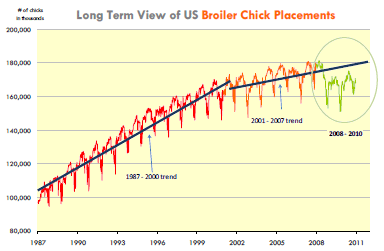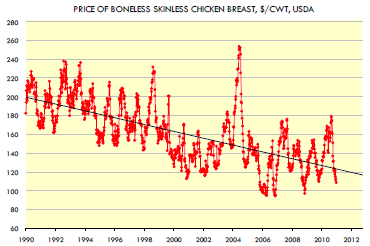



CME: Broiler Sector Shows No Appetite for Growth
US - There was plenty of buzz last year that, after a disastrous 2009, the US broiler industry was poised to start gaining back some of the lost ground, write Steve Meyer and Len Steiner.So far, however, that has not happened and the latest data indicates that the industry is showing little appetite for growth. The latest USDA data for the week ending 1 January showed that producers set 203,370 eggs in incubators, just 0.3 per cent more than the previous year. For the last four reported weeks, egg sets were only 0.1 per cent higher than the previous year. Back in September and October, egg sets were growing at a six per cent rate compared with the previous year but the sharp rise in grain prices, uncertain export market prospects and weak pricing for breast meat has caused many optimistic plans to go on ice – at least for the time being.
We produced the chart below sometime last fall but it has been updated with the latest data. We think it provides a good view of the broader trends in the broiler industry. It is also instructive for beef and pork producers and processors since broiler meat is by far the largest protein in the US market at this time. The chart shows weekly broiler chick placements for the last 25 years, a period that we have broken down in roughly three periods. The first period was 1987-2000, during which the industry grew rapidly. Weekly chick placements were running at about 1000,000 units a week in 1987 but by the end of 2000, they had surpassed 160,000/week As broiler meat, and especially boneless skinless chicken breasts became ever more ubiquitous, the price premiums that producers received began to decline.


The industry faced a significant supply shock when the largest producer (around 25 per cent of total supply) went bankrupt. The bankruptcy of Pilgrim’s Pride becomes even more significant when one considers how tightly integrated the broiler industry has become over the years. It impacted the operations not just of company plants and facilities but also the producers that operated under contract along the entire supply chain. As the chart shows, the industry experienced a net decline in total capacity, one that has yet to return to prior levels. At this time, it will be quite difficult for many operators to institute any meaningful increases given prospects for $6+ corn and $370+ soybean meal. Demand remains key, however, and the price of those chicken breasts (which are still near 25-year lows) indicates that the industry has quite a ways to go to restore margins.








